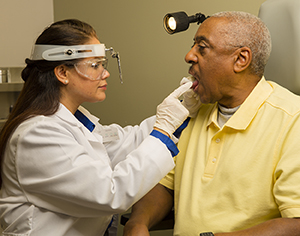Diagnosing a Mouth or Throat Tumor
You have a tumor in your mouth or throat. A tumor is a mass of abnormal cells. To learn more about your tumor, your healthcare provider will evaluate you. This may include a health history, physical exam, and some tests. The results help your provider and healthcare team plan the best treatment for you.
Your health history
Your healthcare provider will take your health history. They'll ask about your health problems, symptoms, and any treatments you’ve had. It's vital that you share all important health information with your provider. If needed, you may be referred to a specialist for more evaluation.
Your physical exam

The physical exam is done in a healthcare provider’s office. The provider will look inside your nose and mouth with a light. They'll also feel your neck and maybe your mouth. The following may be done during the exam as well:
-
Indirect laryngoscopy. A handheld mirror is held to the back of your throat. The provider directs a light to the back of your throat to check the larynx, vocal cords, the base of the tongue, and other tissues in your throat. A numbing medicine may be used to keep you comfortable.
-
Panendoscopy. Different types of tubes (endoscopes) are put into your mouth or nose, and sometimes down into your throat. This is usually done in the hospital with general anesthesia so you can sleep during the test.
Imaging tests
You may have one or more imaging tests. These give your healthcare provider more information about your tumor. You’ll be told how to get ready for these tests ahead of time. Some common imaging tests include:
-
X-ray. This test uses high-energy beams to take a picture of tissues inside the body.
-
CT scan. This uses a computer and X-rays to take detailed pictures of your body.
-
MRI scan. This test uses strong magnets and computers to take images. The test does not use X-rays.
-
PET-CT scan. A PET scan uses a small amount of a radioactive substance to show areas that might be cancer. The PET-CT scan is two tests done at the same time. This creates a more detailed image.
-
Bone Scan. A small amount of low-level radioactive material is injected into the blood and collects mainly in abnormal areas of bone. If the tumor is cancer, this shows if it has spread to bone.
-
Ultrasound.This uses sound waves to create images of the insides of the body. It is used to visualize lymph nodes and to help guide biopsies.
-
Barium swallow. In this test, you drink a chalky liquid called barium that coats the walls of your throat and esophagus. Then X-rays are taken as you swallow to see if there are blockages in the esophagus. Or problems with swallowing.
Direct pharyngoscopy and laryngoscopy
For a closer look at your throat, larynx, and other nearby tissues, your healthcare provider may do direct pharyngoscopy and laryngoscopy. During this test, the provider puts a lighted tube (laryngoscope) into your throat. Direct laryngoscopy is often done in the hospital. You'll be given general anesthesia to help you relax and sleep through the test. The provider may use a small flexible laryngoscope that can pass through your nose into your throat. This is done using a sprayed local anesthetic to numb your nose and throat.
Biopsy
A biopsy means the healthcare provider removes a small sample of your tumor. This sample is then sent to a lab and studied. This test is done to find out if the tumor is cancer. A biopsy may be done in the provider’s office or in the hospital. In some cases, the provider does a biopsy during direct laryngoscopy.
Fine-needle aspiration
For fine-needle aspiration (FNA), the healthcare provider puts a very thin needle attached to a syringe into the tumor. Then they pull out some cells that will be examined in a lab. This type of biopsy is sometimes done in the provider’s office.
Deciding on treatment
Treatment depends on the tumor’s size, type, and where it is. Treatment also depends on if the tumor is cancer. Treatment may include one or more of the following:
-
Surgery
-
Radiation therapy
-
Chemotherapy
-
Immunotherapy